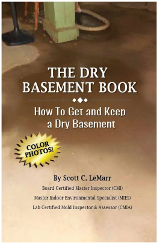Home Investigation
How do I tell if I have a mold problem?
Investigate: The most practical way to find a mold problem is by using your eyes to look for mold growth and by using your nose to locate the source of a suspicious odor. If you see mold or if there is an earthy or musty smell, you should assume a mold problem exists. Other clues are signs of excess moisture or the worsening of allergy-like symptoms.
Moisture Intrusion: Mold needs moisture and food to grow and produce spores. Any source of moisture can provide the right conditions for growth. Leaking pipes, Leaking bathtub, Leaking shower, Chimney flashings, Soil stack flashings, Roof vents, Skylights, Water intrusion inot the basment from flooding or even negative grade can all provide the right conditions for mold growth. Food can be wood, paper, drywall (which is paper), material, and dirt. Mold growing on metal objects or concrete typically is growing on the dirt attached to the material.
Look for visible mold growth (may appear cottony, velvety, granular, or leathery and have varied colors of white, gray, brown, black, yellow, green). Mold often appears as discoloration, staining, or fuzzy growth on the surface of building materials or furnishings. When mold is visible, Milwaukee Mold Inspector, a division of Honest Home Inspections, recommends testing to determine the type of mold we are dealing with.
We can Test: We will be happy to come out and take a look at your problem. For visible mold we can swab test and determine the type of molds we are dealing with. For the musty odor and/or suspect mold we can provide an air quality test, which will determine the amount of and the type of mold spores that are currently floating in your home.
Why shouldn't I just clean up the surface with bleach and water?
Contrary to popular belief, Bleach does not really work well for Mold clean up. Hot water with an anti-bacterial soap can work well on non pourus surfaces, however anytime you so much as touch the mold or wave your hand across it you are releasing tens of thousand of spores into the air and often into you lungs, eyes, ears, on your clothing, and any surrounding surfaces like carpet and drywall. The type of mold should be determined before any clean up should take place. After you know what type of Mold you have and if you feel so inclined to clean it up yourself, please use the appropriate gear, a mold respirator, ear plugs, eye shields, etc. However, professional mold remediation is generally recommended.
Should I test for mold?
The Do-It-Yourself kits typically tell you what type of mold you may have but will not tell you how much and if it is a concern, This do-it-yourself process really cannot take the place of a certified and trained technician using lab certified equipment. Instead of testing yourself, you should simply assume there is a problem whenever you see mold or smell mold odors. Testing should never take the place of visual inspection and it should never use up resources that are needed to correct moisture problems and remove all visible growth.
Sometimes, mold growth is hidden and difficult to locate. In such cases, a combination of air (outdoor and indoor air samples) and bulk (material) samples may help determine the extent of contamination and where cleaning is needed. We often use thermal imaging cameras and moisture meters as diagnostic tools.
Scott LeMarr is trained and certified by Pro-Lab and Enviromental Solutions Association (ESA) in Mold Inspection, Mold Assessment, Mold sampling,and he is a Certified Indoor Air Quality Technician (CIAQT) . He has extensive knowledge of mold, how it grows, spreads, and causes problems. He has been professionally trained to inspect for the presence of mold and on the proper sampling methods required to provide fast and accurate results. In addtion, Scott has reached the Certification of Master Indoor Environmental Specialist. The highest certification ESA provides and is a level I Thermographer.
All samples taken are sent to a third party AIHA accredited laboratory for identification and Mr. LeMarr has the skills and knowledge required to properly interpret the laboratory results. You will be provided with a Certified Mold Inspection Report detailing the extent of the mold problem, usually by email. Should you need the report for legal proceedings, a Chain of Custody form from the time of collection to the time of processing at the laboratory can be provided. The Chain of Custody procedures are an important element should you find yourself in any legal proceedings as a result of mold complications.
Don't take chances with the health of your family members. If you suspect a mold problem, please give us a call, and let's get it corrected.





